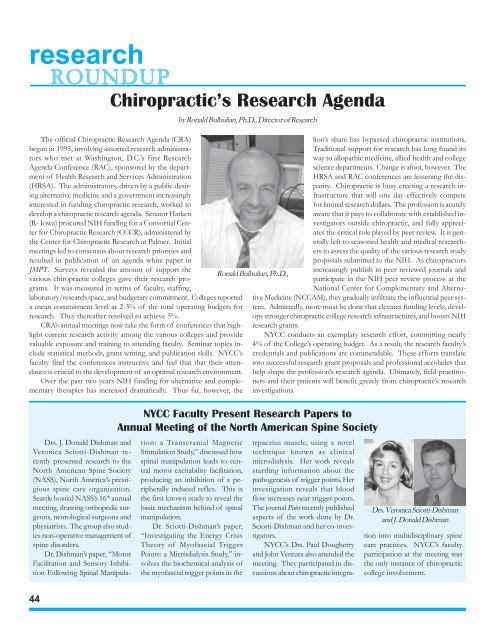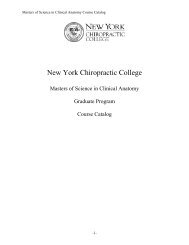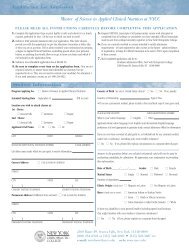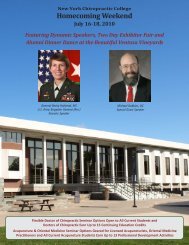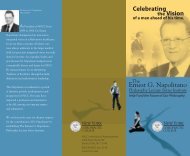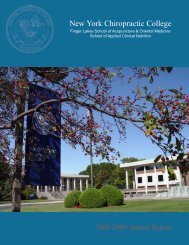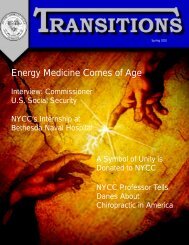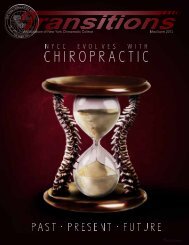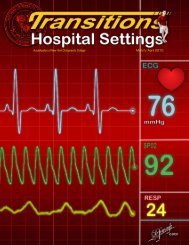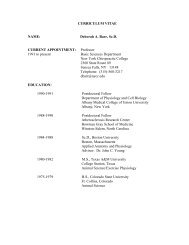2502 NYCC TRANS FINAL2 - New York Chiropractic College
2502 NYCC TRANS FINAL2 - New York Chiropractic College
2502 NYCC TRANS FINAL2 - New York Chiropractic College
You also want an ePaper? Increase the reach of your titles
YUMPU automatically turns print PDFs into web optimized ePapers that Google loves.
esearch<br />
ROUNDUP<br />
<strong>Chiropractic</strong>’s Research Agenda<br />
by Ronald Bulbulian, Ph.D., Director of Research<br />
The official <strong>Chiropractic</strong> Research Agenda (CRA)<br />
lion’s share has bypassed chiropractic institutions.<br />
began in 1995, involving assorted research administrators<br />
who met at Washington, D.C.’s first Research<br />
way to allopathic medicine, allied health and college<br />
Traditional support for research has long found its<br />
Agenda Conference (RAC), sponsored by the department<br />
of Health Research and Services Administration<br />
HRSA and RAC conferences are lessening the dis-<br />
science departments. Change is afoot, however. The<br />
(HRSA). The administrators, driven by a public desiring<br />
alternative medicine and a government increasingly<br />
frastructure that will one day effectively compete<br />
parity. <strong>Chiropractic</strong> is busy erecting a research in-<br />
interested in funding chiropractic research, worked to<br />
for limited research dollars. The profession is acutely<br />
develop a chiropractic research agenda. Senator Harken<br />
aware that it pays to collaborate with established investigators<br />
outside chiropractic, and fully appreci-<br />
(R- Iowa) procured NIH funding for a Consortial Center<br />
for <strong>Chiropractic</strong> Research (CCCR), administered by<br />
ates the critical role played by peer review. It is generally<br />
left to seasoned health and medical research-<br />
the Center for <strong>Chiropractic</strong> Research at Palmer. Initial<br />
meetings led to consensus about research priorities and<br />
ers to assess the quality of the various research study<br />
resulted in publication of an agenda white paper in<br />
proposals submitted to the NIH. As chiropractors<br />
JMPT. Surveys revealed the amount of support the<br />
increasingly publish in peer reviewed journals and<br />
Ronald Bulbulian, Ph.D.,<br />
various chiropractic colleges gave their research programs.<br />
It was measured in terms of faculty, staffing,<br />
National Center for Complementary and Alterna-<br />
participate in the NIH peer review process at the<br />
laboratory/research space, and budgetary commitment. <strong>College</strong>s reported tive Medicine (NCCAM), they gradually infiltrate the influential peer system.<br />
Admittedly, more must be done that elevates funding levels, devel-<br />
a mean commitment level at 2-3% of the total operating budgets for<br />
research. They thereafter resolved to achieve 5%.<br />
ops stronger chiropractic college research infrastructures, and boosts NIH<br />
CRA’s annual meetings now take the form of conferences that highlight<br />
current research activity among the various colleges and provide <strong>NYCC</strong> conducts an exemplary research effort, committing nearly<br />
research grants.<br />
valuable exposure and training to attending faculty. Seminar topics include<br />
statistical methods, grant writing, and publication skills. <strong>NYCC</strong>’s credentials and publications are commendable. These efforts translate<br />
4% of the <strong>College</strong>’s operating budget. As a result, the research faculty’s<br />
faculty find the conferences instructive and feel that that their attendance<br />
is crucial to the development of an optimal research environment. help shape the profession’s research agenda. Ultimately, field practitio-<br />
into successful research grant proposals and professional accolades that<br />
Over the past two years NIH funding for alternative and complementary<br />
therapies has increased dramatically. Thus far, however, the<br />
ners and their patients will benefit greatly from chiropractic’s research<br />
investigations.<br />
<strong>NYCC</strong> Faculty Present Research Papers to<br />
Annual Meeting of the North American Spine Society<br />
trpaezius muscle, using a novel<br />
technique known as clinical<br />
microdialysis. Her work reveals<br />
startling information about the<br />
pathogenesis of trigger points. Her<br />
investigation reveals that blood<br />
flow increases near trigger points.<br />
The journal Pain recently published<br />
aspects of the work done by Dr.<br />
Sciotti-Dishman and her co-investigators.<br />
<strong>NYCC</strong>’s Drs. Paul Dougherty<br />
and John Ventura also attended the<br />
meeting. They participated in discussions<br />
about chiropractic integration:<br />
a Transcranial Magnetic<br />
Stimulation Study,” discussed how<br />
spinal manipulation leads to central<br />
motor excitability facilitation,<br />
producing an inhibition of a peripherally<br />
induced reflex. This is<br />
the first known study to reveal the<br />
basic mechanism behind of spinal<br />
manipulation.<br />
Dr. Sciotti-Dishman’s paper,<br />
“Investigating the Energy Crisis<br />
Theory of Myofascial Trigger<br />
Points: a Microdialysis Study,” involves<br />
the biochemical analysis of<br />
the myofascial trigger points in the<br />
Drs. J. Donald Dishman and<br />
Veronica Sciotti-Dishman recently<br />
presented research to the<br />
North American Spine Society<br />
(NASS), North America’s prestigious<br />
spine care organization.<br />
Seattle hosted NASS’s 16 th annual<br />
meeting, drawing orthopedic surgeons,<br />
neurological surgeons and<br />
physiatrists. The group also studies<br />
non-operative management of<br />
spine disorders.<br />
Dr. Dishman’s paper, “Motor<br />
Facilitation and Sensory Inhibition<br />
Following Spinal Manipula-<br />
Drs. Veronica Sciotti-Dishman<br />
and J. Donald Dishman<br />
tion into multidisciplinary spine<br />
care practices. <strong>NYCC</strong>’s faculty<br />
participation at the meeting was<br />
the only instance of chiropractic<br />
college involvement.<br />
44


